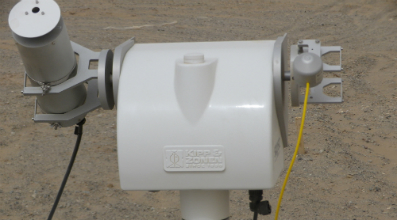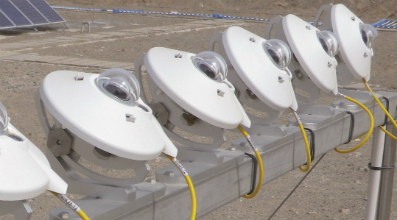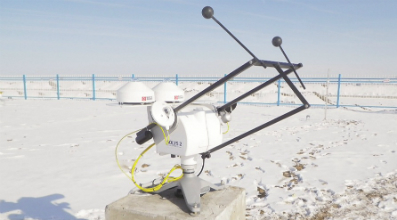This year our Chinese distributor Beijing Techno Solutions installed a unique meteorological observation system in the Gobi for its customer Beijing Hua Sheng Ji Zhi New Energy Technology. This is a solar energy field test station in Dunhuang, Gansu Province, China.
The observation field has a size of 40 by 30 meters and is divided into 6 zones for; spectral measurement, tilted global radiation measurement, wind speed and direction, dual axis tracking solar radiation, rainfall observation and comprehensive meteorological measurements.
 The spectral measurements of direct solar radiation in zone 1 are measured with our PGS-100 Sun Photometer. This spectrophotometer is mounted on a SOLYS 2 sun tracker with integrated active sun sensor correction. The SOLYS 2 is mounted on a platform and the PGS-100 is directly connected to a computer to download spectral data in the wavelength range from 350 to 1050 nm.
The spectral measurements of direct solar radiation in zone 1 are measured with our PGS-100 Sun Photometer. This spectrophotometer is mounted on a SOLYS 2 sun tracker with integrated active sun sensor correction. The SOLYS 2 is mounted on a platform and the PGS-100 is directly connected to a computer to download spectral data in the wavelength range from 350 to 1050 nm.
The data can be processed to obtain the following parameters; optical thickness, scattering coefficient; aerosol distribution, energy distribution, absorption rate through the atmosphere and the irradiance.
 Zone 2 is installed with seven tilted CMP 11 pyranometers. Each pyranometer is tilted at a different angle (10°, 20°,30°, 40°, 50°, 60° and 70°) to determine the optimum angle for fixed solar panels in this region in the future. The measurement data is recorded by Campbell Scientific CR3000 data loggers.
Zone 2 is installed with seven tilted CMP 11 pyranometers. Each pyranometer is tilted at a different angle (10°, 20°,30°, 40°, 50°, 60° and 70°) to determine the optimum angle for fixed solar panels in this region in the future. The measurement data is recorded by Campbell Scientific CR3000 data loggers.
There is one more zone with Kipp & Zonen instruments, zone 4, with a complete solar monitoring station based on a SOLYS 2 sun tracker. A CHP 1 pyrheliometer measures direct solar irradiance and there are three CMP 21 pyranometers to provide measurement of global, diffuse and 2-axis tilted solar irradiance. All the radiometers are connected to a data logger.
The remaining zones are installed with a wind observation system that includes a 10 m high tower, a rainfall observation system, with a horizontally mounted precipitation sensor, and a general observation platform with temperature, humidity and pressure sensors.
With this scientific meteorological observation site, Beijing Hua Sheng Ji Zhi New Energy Technology is testing the possibilities of the Gobi region for solar energy installations. The data obtained will help to choose the best technology, the best angle for fixed PV panel installation, and the expected solar energy budget.
